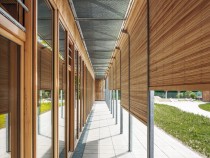
© Christian Richters
In order to comply with a politically determined increase in the number of places in day nurseries, the city of Frankfurt held an architectural competition in 2009 in which it called for the development of a basic type of structure for infants under the age of three. What was sought was a modular building system that could, on the one hand, be implemented economically and, on the other, be adapted to various locations and to meet individual circumstances. Among the five equal prizewinners of the competition were MGF Architects with their proposal for the creation of a single-storey timber building constructed with prefabricated elements. Cut into the long faces of the elongated structure were courtyards that articulate the overall volume into comprehensible units. This project was implemented in a revised form on the outskirts of Schwanheim, an urban district in the south-west of Frankfurt.
In spite of the quite different spatial concepts, of these two nurseries, their construction is almost identical. The load-bearing internal walls consist of solid laminated cross-boarding, the outer walls of insulated timber-frame elements and the roofs of load-bearing and sound-absorbing hollow box-beam elements. All building components were prefabricated at works and transported to site for erection. In the case of the internal walls, the doors and windows, as well as chases, recesses and borings for electrical runs, sockets and switches, were formed at works.
The selection of building materials reflects both the means of fabrication and the ecological constraints. The use of natural components free of deleterious substances had priority. For example, all internal timber surfaces are untreated. With an innate logic, the two buildings have very low heating-energy needs of only 22 and 15 kWh/m2a, which are the result of highly insulated building skins, triple glazing and ventilation with heat recovery.
In spite of the quite different spatial concepts, of these two nurseries, their construction is almost identical. The load-bearing internal walls consist of solid laminated cross-boarding, the outer walls of insulated timber-frame elements and the roofs of load-bearing and sound-absorbing hollow box-beam elements. All building components were prefabricated at works and transported to site for erection. In the case of the internal walls, the doors and windows, as well as chases, recesses and borings for electrical runs, sockets and switches, were formed at works.
The selection of building materials reflects both the means of fabrication and the ecological constraints. The use of natural components free of deleterious substances had priority. For example, all internal timber surfaces are untreated. With an innate logic, the two buildings have very low heating-energy needs of only 22 and 15 kWh/m2a, which are the result of highly insulated building skins, triple glazing and ventilation with heat recovery.













